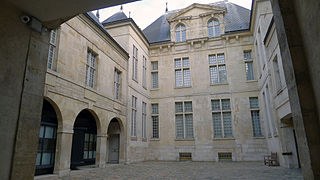
The Louvre, or the Louvre Museum, is the world's most-visited museum, and a historic landmark in Paris, France. It is the home of some of the best-known works of art, including the Mona Lisa and the Venus de Milo. A central landmark of the city, it is located on the Right Bank of the Seine in the city's 1st arrondissement. At any given point in time, approximately 38,000 objects from prehistory to the 21st century are being exhibited over an area of 72,735 square meters. Attendance in 2021 was 2.8 million due to the COVID-19 pandemic. The museum was closed for 150 days in 2020, and attendance plunged by 72 percent to 2.7 million. Nonetheless, the Louvre still topped the list of most-visited art museums in the world in 2020.

The Musée d'Orsay is a museum in Paris, France, on the Left Bank of the Seine. It is housed in the former Gare d'Orsay, a Beaux-Arts railway station built between 1898 and 1900. The museum holds mainly French art dating from 1848 to 1914, including paintings, sculptures, furniture, and photography. It houses the largest collection of Impressionist and post-Impressionist masterpieces in the world, by painters including Berthe Morisot, Monet, Manet, Degas, Renoir, Cézanne, Seurat, Sisley, Gauguin, and Van Gogh. Many of these works were held at the Galerie nationale du Jeu de Paume prior to the museum's opening in 1986. It is one of the largest art museums in Europe.

Les Eyzies-de-Tayac-Sireuil is a former commune in the Dordogne department in Nouvelle-Aquitaine in southwestern France. On 1 January 2019, it was merged into the new commune Les Eyzies.

The Musée Carnavalet in Paris is dedicated to the history of the city. The museum occupies two neighboring mansions: the Hôtel Carnavalet and the former Hôtel Le Peletier de Saint Fargeau. On the advice of Baron Haussmann, the civil servant who transformed Paris in the latter half of the 19th century, the Hôtel Carnavalet was purchased by the Municipal Council of Paris in 1866; it was opened to the public in 1880. By the latter part of the 20th century, the museum was full to capacity. The Hôtel Le Peletier de Saint Fargeau was annexed to the Carnavalet and opened to the public in 1989.

The Montreal Museum of Fine Arts is an art museum in Montreal, Quebec, Canada. It is the largest art museum in Canada by gallery space. The museum is located on the historic Golden Square Mile stretch of Sherbrooke Street.

The Musée national de la Marine is a maritime museum located in the Palais de Chaillot, Trocadéro, in the 16th arrondissement of Paris. It has annexes at Brest, Port-Louis, Rochefort, Toulon and Saint-Tropez. The permanent collection originates in a collection that dates back to Louis XV of France.

The Musée de l'Armée is a national military museum of France located at Les Invalides in the 7th arrondissement of Paris. It is served by Paris Métro stations Invalides, Varenne, and La Tour-Maubourg.

The Musée des Arts décoratifs is a museum dedicated to the exhibition and preservation of the decorative arts. Located at 107 Rue de Rivoli in the city's 1st arrondissement, the museum occupies the most north-western wing of the Palais du Louvre, known as the Pavillon de Marsan. With over one million objects in its collection, the Musée des Arts décoratifs is the largest museum of decorative arts in continental Europe.

The Musée de l'Homme is an anthropology museum in Paris, France. It was established in 1937 by Paul Rivet for the 1937 Exposition Internationale des Arts et Techniques dans la Vie Moderne. It is the descendant of the Musée d'Ethnographie du Trocadéro, founded in 1878. The Musée de l'Homme is a research center under the authority of various ministries, and it groups several entities from the CNRS. The Musée de l'Homme is one of the seven departments of the Muséum national d'histoire naturelle. The Musée de l'Homme occupies most of the Passy wing of the Palais de Chaillot in the 16th arrondissement. The vast majority of its collection was transferred to the Quai Branly museum.

The Musée national des beaux-arts du Québec, abbreviated as MNBAQ, is an art museum in Quebec City, Quebec, Canada. The museum is situated in Battlefield Park and is a complex consisting of four buildings. Three of the buildings were purpose-built for the museum. One building was initially built as a provincial prison before being repurposed for museum use.

Sèvres – Cité de la céramique is a French national ceramics museum located at the Place de la Manufacture, Sèvres, Hauts-de-Seine, a suburb of Paris, France. It was created in January 2010, from the merger of the Musée national de Céramique-Sèvres and the Manufacture nationale de Sèvres. The museum is open daily except Tuesday; an admission fee is charged. Access to the museum by public transportation is available from Tramway d'Île-de-France station Musée de Sèvres on Tramway T2, and by Paris Métro station Pont de Sèvres on Line 9.
The Musée de la Cinémathèque, formerly known as Musée du Cinéma – Henri Langlois, is a museum of cinema history located in the Cinémathèque française, 51 rue de Bercy in the 12th arrondissement of Paris. It presents the living history of moving pictures and pre-cinema, from their origins to the present day and in all countries, with collections of more than 5,000 movie-related objects including cameras, movie scripts and sets, photographic stills, costumes worn by actors like Rudolph Valentino and Marilyn Monroe, and showed several early movies from the important collection of the Cinémathèque.

The Musée Cognacq-Jay is a museum located in the Hôtel Donon in the 3rd arrondissement at 8 rue Elzévir, Paris, France. It is open daily except Monday; admission is free. The nearest Metro stations are Saint-Paul and Chemin Vert.
The Musée Préfectoral de Kissidougou is a museum in Kissidougou, Guinea. It is noted for its collection of masks, which are believed to have magical powers.